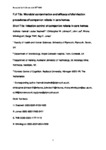Microbial contamination and efficacy of disinfection procedures of companion robots in care homes
| dc.contributor.author | Bradwell, Hannah | |
| dc.contributor.author | Johnson, CW | |
| dc.contributor.author | Lee, J | |
| dc.contributor.author | Winnington, R | |
| dc.contributor.author | Thill, S | |
| dc.contributor.author | Jones, Ray | |
| dc.date.accessioned | 2020-09-15T08:17:52Z | |
| dc.date.issued | 2020-08-26 | |
| dc.identifier.issn | 1932-6203 | |
| dc.identifier.issn | 1932-6203 | |
| dc.identifier.other | ARTN e0237069 | |
| dc.identifier.uri | http://hdl.handle.net/10026.1/16278 | |
| dc.description.abstract |
BACKGROUND: Paro and other robot animals can improve wellbeing for older adults and people with dementia, through reducing depression, agitation and medication use. However, nursing and care staff we contacted expressed infection control concerns. Little related research has been published. We assessed (i) how microbiologically contaminated robot animals become during use by older people within a care home and (ii) efficacy of a cleaning procedure. METHODS: This study had two stages. In stage one we assessed microbial load on eight robot animals after interaction with four care home residents, and again following cleaning by a researcher. Robot animals provided a range of shell-types, including fur, soft plastic, and solid plastic. Stage two involved a similar process with two robot animals, but a care staff member conducted cleaning. The cleaning process involved spraying with anti-bacterial product, brushing fur-type shells, followed by vigorous top-to-tail cleaning with anti-bacterial wipes on all shell types. Two samples were taken from each of eight robots in stage one and two robots in stage two (20 samples total). Samples were collected using contact plate stamping and evaluated using aerobic colony count and identification (gram stain, colony morphology, coagulase agglutination). Colony counts were measured by colony forming units per square centimetre (CFU/cm2). RESULTS: Most robots acquired microbial loads well above an acceptable threshold of 2.5 CFU/cm2 following use. The bacteria identified were micrococcus species, coagulase negative staphylococcus, diptheriods, aerobic spore bearers, and staphylococcus aureus, all of which carry risk for human health. For all devices the CFU/cm2 reduced to well within accepted limits following cleaning by both researcher and care staff member. CONCLUSIONS: Companion robots will acquire significant levels of bacteria during normal use. The simple cleaning procedure detailed in this study reduced microbial load to acceptable levels in controlled experiments. Further work is needed in the field and to check the impact on the transmission of viruses. | |
| dc.format.extent | e0237069-e0237069 | |
| dc.format.medium | Electronic-eCollection | |
| dc.language | en | |
| dc.language.iso | en | |
| dc.publisher | Public Library of Science (PLoS) | |
| dc.rights | Attribution-NonCommercial-NoDerivatives 4.0 International | |
| dc.rights | Attribution-NonCommercial-NoDerivatives 4.0 International | |
| dc.rights | Attribution-NonCommercial-NoDerivatives 4.0 International | |
| dc.rights | Attribution-NonCommercial-NoDerivatives 4.0 International | |
| dc.rights | Attribution-NonCommercial-NoDerivatives 4.0 International | |
| dc.rights | Attribution-NonCommercial-NoDerivatives 4.0 International | |
| dc.rights.uri | http://creativecommons.org/licenses/by-nc-nd/4.0/ | |
| dc.rights.uri | http://creativecommons.org/licenses/by-nc-nd/4.0/ | |
| dc.rights.uri | http://creativecommons.org/licenses/by-nc-nd/4.0/ | |
| dc.rights.uri | http://creativecommons.org/licenses/by-nc-nd/4.0/ | |
| dc.rights.uri | http://creativecommons.org/licenses/by-nc-nd/4.0/ | |
| dc.rights.uri | http://creativecommons.org/licenses/by-nc-nd/4.0/ | |
| dc.subject | Aged | |
| dc.subject | Aged, 80 and over | |
| dc.subject | Bacteria | |
| dc.subject | Colony Count, Microbial | |
| dc.subject | Cross Infection | |
| dc.subject | Disinfectants | |
| dc.subject | Disinfection | |
| dc.subject | Equipment Contamination | |
| dc.subject | Humans | |
| dc.subject | Nursing Homes | |
| dc.subject | Robotics | |
| dc.subject | Staphylococcal Infections | |
| dc.title | Microbial contamination and efficacy of disinfection procedures of companion robots in care homes | |
| dc.type | journal-article | |
| dc.type | Journal Article | |
| dc.type | Research Support, Non-U.S. Gov't | |
| plymouth.author-url | https://www.webofscience.com/api/gateway?GWVersion=2&SrcApp=PARTNER_APP&SrcAuth=LinksAMR&KeyUT=WOS:000566205500010&DestLinkType=FullRecord&DestApp=ALL_WOS&UsrCustomerID=11bb513d99f797142bcfeffcc58ea008 | |
| plymouth.issue | 8 | |
| plymouth.volume | 15 | |
| plymouth.publication-status | Published online | |
| plymouth.journal | PLOS ONE | |
| dc.identifier.doi | 10.1371/journal.pone.0237069 | |
| plymouth.organisational-group | /Plymouth | |
| plymouth.organisational-group | /Plymouth/Faculty of Health | |
| plymouth.organisational-group | /Plymouth/Faculty of Health/School of Nursing and Midwifery | |
| plymouth.organisational-group | /Plymouth/REF 2021 Researchers by UoA | |
| plymouth.organisational-group | /Plymouth/REF 2021 Researchers by UoA/UoA03 Allied Health Professions, Dentistry, Nursing and Pharmacy | |
| plymouth.organisational-group | /Plymouth/Research Groups | |
| plymouth.organisational-group | /Plymouth/Research Groups/Institute of Health and Community | |
| plymouth.organisational-group | /Plymouth/Users by role | |
| plymouth.organisational-group | /Plymouth/Users by role/Academics | |
| dc.publisher.place | United States | |
| dcterms.dateAccepted | 2020-07-20 | |
| dc.rights.embargodate | 2020-9-18 | |
| dc.identifier.eissn | 1932-6203 | |
| dc.rights.embargoperiod | Not known | |
| rioxxterms.versionofrecord | 10.1371/journal.pone.0237069 | |
| rioxxterms.licenseref.uri | http://creativecommons.org/licenses/by-nc-nd/4.0/ | |
| rioxxterms.licenseref.startdate | 2020-08-26 | |
| rioxxterms.type | Journal Article/Review |



